Remember your first ever Christmas show – its sparkle and magic, its tinsel and thrall? I watched my first pantomime in 1978, though I couldn’t have named it as such. I was six, and still acclimatising to the shock of leaving sun-soaked Lahore to migrate to the greyest of London winters. I was led into the school hall where I sat, legs folded, with no friends and no word of English. I remember the curtain opening to a hirsute dame playing a guitar, and a half-hearted pantomime horse with elbows and heads poking out of its sides. An explosion of boos, whoops and shrieks. Classmates shouting, teachers hissing. What madness was this, and how had it managed to crack the room open to such rapture?
That first rickety school panto left me with an abiding, child’s delight for Christmas shows. Like many Muslims (and Jews, Hindus, Sikhs), I did not grow up celebrating Christmas. But I have embraced the great British tradition of the Christmas show, from the lovable mayhem of an end-of-year school play to the dazzle and splash of a West End production, the stupendous ensemble of a Royal Opera House staple such as The Nutcracker, right up to my annual family pantomime, which last year turned out to be a retelling of Cinderella featuring a same-sex romance between a stepsister and a female Buttons.
“But girls can’t marry each other,” whispered my young niece beside me, as the curtain closed on a double wedding.
“Actually, they can,” I whispered back and saw her face blaze with wondrous new knowledge of the world.
The Christmas show’s appeal is not only the show itself; for a few weeks each year we come together in kitschness, to see stories being retold and to holler out phrases we have been hollering since we were children (“He’s behiiiiind you!”). It reminds us of who we were, in that school hall, and the joy we felt in what might have been our earliest encounters with live performance.
For me, it adds a broader, richer, cultural hinterland to a day I do not hold particularly dear, and comforts me at a time when I am bedding down for the dark, long days of winter. The theatrical knees-up fortifies us against the hibernating gloom to come, warming us with its carnivalesque dames and hedonistic reminders to eat, rejoice, be merry, while we can.
And never more so than this year, after months of pandemic darkness. As I write, the Christmas show carousel is whirling into motion and some theatres are rising out of a 10-month closure, hoping to swing open their doors. Here they are: the Jack And The Beanstalks, the Snow Queens, a dizzying number of Christmas Carols. There are also plenty of theatres still closed, with productions postponed or cancelled, and thousands of pounds the poorer. The Nottingham Playhouse, in a Tier 3 region, will stage its Cinderella online nonetheless. There is something steely and indestructible about the genre.
Last year, the National Theatre’s seasonal offering was an adaptation of Neil Gaiman’s fantasy novel Ocean At The End Of The Lane. This year, it has opted for the far more old-school Dick Whittington. Perhaps this is a retreat to the safe stories we know only too well – the equivalent of TV repeats of It’s A Wonderful Life, or Pride And Prejudice remakes – but it is welcome all the same. We have been locked out of theatres for so long and denied their communal pleasures. We need to be reminded of, and reassured by, our favourite childhood stories.
Some shows are offering online alternatives. This is pragmatic but, like so many others, I crave flesh-and-blood actors standing a few feet away from me, an audience that laughs and claps and gasps as one. Even as a theatre critic, I hadn’t realised just how much power lay in sitting together in this way. Socially-distanced theatre is better than nothing: at least we can look across the gap-toothed seating of an auditorium and smile at each other from under our masks.
My biggest surprise during the first lockdown was that theatre-makers kept going – some sharing shows online that had been filmed before, but many made subsequently using interactive technology. They showed us how resourceful the industry is, and created a hybrid new form: theatre made for film, available for free, or at a fraction of the cost of a West End seat. It was a lifeline and a democratising force, but it had its frustrations. Theatre is a three-dimensional medium but here it felt flattened; live performance that could be paused, rewound, watched while eating dinner or texting (sorry!). Live theatre resists such 21st-century multitasking: that is what makes it so unique.
Much of what I saw was commendable. It was certainly heroic. Some of it worked, and it got cleverer, more technologically inventive, with time. I was bowled over by a remake of Jonathan Coe’s What A Carve Up! and even now can’t imagine a more imaginative adaptation on stage. Playwrights such as Alan Ayckbourn, David Greig and Mike Bartlett wrote audio plays. There is nothing new in this, but “listening” took on newfound value for me, above the rigours of screen time; the audio drama felt like a liberation.
If that first lockdown left me melancholic for the future of British theatre, there were unexpected highs. Suddenly, I was back speaking to actors and directors on the phone, and because we all had time to talk, we really talked. I spent an hour on a call to Gillian Anderson. “It’s fine,” she said when I apologised, and then she kept on going. I told Mark Gatiss about my surprising new love of cleaning. “You can come round to mine in that case,” he said. I Zoomed with Matt Smith and Claire Foy, and felt like a gooseberry in their quickfire to and fro. When would this have happened in the real world of hard-and-fast timings and PR people rustling in to shut the conversation down?
A weekly highlight was my chat with Paul Hart, artistic director of the Watermill theatre in Newbury, who updated me on how he was keeping this beautiful place afloat. Every week, he was presented with a new horror and refused to be cowed by it. He was pushing up his sleeves for the Christmas season when we last spoke. The show, A Christmas Carol, was going ahead, he said, and his determination left a lump in my throat.
When that first lockdown lifted and venues blinked awake, I felt heady as I re-entered an auditorium, even with its aircraft-like seating arrangements and one-way systems. I spent half a day behind the scenes of Sleepless, the first major musical to reopen in Britain, and was unprepared for the burst of euphoria when I heard one of its stars, Jay McGuiness, rehearse on stage; the lights, live orchestra and song went straight through my body. This was theatre, in all its gorgeous physicality. It was meant not only to be seen but to be felt, up close. I was hit by the same force of emotion when the audience first laughed together at David Hare’s pungent Covid drama Beat The Devil at the Bridge theatre, and moved to tears when I went into the Olivier theatre at the National on the opening night of Clint Dyer and Roy Williams’ Death Of England: Delroy, which simultaneously became its closing night when the second lockdown was announced. The auditorium was all but unrecognisable – now in the round, with Plexiglass around the stage. I was not saddened by the reduced capacity or the distancing measures, but moved by the will and courage of it.
I felt changed as a person, too. Up until lockdown, I had gone to the theatre to do my job – head down, notebook in hand, tiptoeing out as the lights went back up. I was like a commuter in a train carriage, looking directly ahead and feeling impatient among the slowly sashaying foyer crowd. Not so now. I greeted fellow critics like old friends and talked to strangers sitting a few feet away. Theatre became something far bigger than it had been before.
This is what I hold on to now, as I head out again to my umpteenth Christmas Carol – that it is not just what happens under the proscenium arches that makes theatre so magical. It is the people who turn up to see it, the stewards who smile and serve ice-cream, the Christmas lights that twinkle all the brighter as you re-emerge. The corny fake snow, the mince pies in the foyer and the physical spaces themselves – from the handsome, high gilt ceilings to the steel solidity of the light-rigging – are all part of the glory.
Some weeks ago, the West End producer Sonia Friedman spoke to director Ian Rickson on his podcast, What I Love, and said she felt as if the nation’s theatres were “waiting patiently and proudly for us” to reconvene inside. Yes, I thought, and until they are filled again, the ghost of Christmas shows past – and the postponed present – shall no doubt roam the empty aisles, restless for the future to arrive with all its tinselly joys. AA
‘This is the longest I’ve ever gone without dancing’
Matthew Koon, 26, Merlin, Northern Ballet, Leeds and on tour; postponed until September 2021
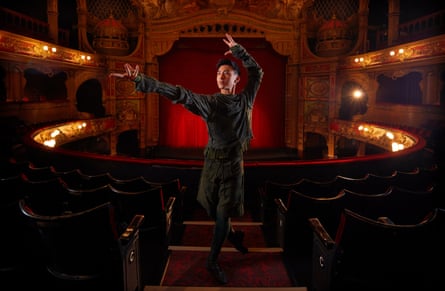
“Christmas and theatre, for me they go hand in hand,” says dancer Matthew Koon. “Growing up, Christmas holidays meant going to the ballet or panto or musical theatre with my family.”
Now that he’s a first soloist with Leeds-based Northern Ballet, Christmas is usually the busiest time of the year. Koon should have been performing in a new ballet, Merlin, by choreographer Drew McOnie, and was about to start rehearsals when the country went into lockdown in March. By July, it was clear they wouldn’t make it back in time and the show was postponed until next year.
Koon took part in workshops with McOnie in 2019, but the ballet doesn’t yet exist beyond that. “We know it’s going to be a reimagining of the tale of Merlin,” he says. “We’re expecting romance and battles and lots of magic, but apart from that… we don’t know!”
Koon started dancing aged two, playing Billy Elliot on stage at 12, and went into full-time ballet training at 16: “This is the longest I’ve ever gone without dancing, so that was scary.” Furloughed, he decided to take a rare break. “The one positive was allowing my body the rest it needed,” he says.
He also took time to explore other skills, working with an acting coach over Zoom and studying for a creative arts degree. “I signed up to pretty much every online course I could,” he says, “and in light of Black Lives Matter, I reflected on how I can bring anti-racism into my work.”
This Christmas will be the first in 25 years that Northern Ballet haven’t put on a production, but Koon is optimistic. “We’ve got lots of exciting rep in the pipeline,” he says, “and the shows that have gone on sale have sold out. So there’s definitely a hunger for theatre to come back.” LW
‘This time I’ve got a prosthetic beard. Blissful. I can just whip it off’
Marcus Hendry, 47, Father Christmas, Lyric Hammersmith, London; online only

In the normal run of things, Marcus Hendry knows when winter is coming: he gets a call in September telling him it’s time to grow a beard. For the last three years, Hendry has appeared in the title role at Lyric Hammersmith’s long-running live version of Raymond Briggs’s Father Christmas.
This year, the call didn’t come until a few weeks ago – and the request was a little different. Instead of booking Hendry for his usual month-long run as Briggs’s curmudgeonly Santa, the theatre is abandoning the live show and recording it for online streaming instead, until Christmas Eve.
“Normally we do it in the studio space, but apparently it’s safer to film it in the main theatre,” Hendry says, then sighs. “Just my luck: my one time in the main house, and no audience.”
The pandemic brought nearly all of Hendry’s film and stage work to a halt. Even his improv group, Foghorn Unscripted, was unable to find a stage; when lockdown eased in the summer, many theatres couldn’t afford to reopen. If Hendry didn’t also work on the operations team at Birmingham’s Utilita Arena, which gave him some furlough pay, he isn’t sure what he would have done. “This year has been like walking through fog,” he says. He’s especially worried about recent drama graduates, who won’t get seen by agents. “This will be brutal for them.”
All of which means that slipping back into the red suit, even for a day and a half of filming, has been a pleasure. “It’s a lovely show, really intimate and joyful,” he says. “And the kids get lost in it: for many of them, it’s their first time seeing theatre. One time this little boy fell off his chair, he was so wrapped up in the show.” If that happens when a family watches the recorded show, Hendry won’t know – but, on the upside, he won’t have to wait until new year to shave off the beard. “This time I’ve got a prosthetic one,” he laughs. “Blissful. I can just whip it off.” AD
‘We used to complain about having nine shows a week. Now we’d happily do it’
Ashley Shaw, 31, Matthew Bourne’s Nutcracker!, Sadler’s Wells, London, and on tour; postponed until December 2021
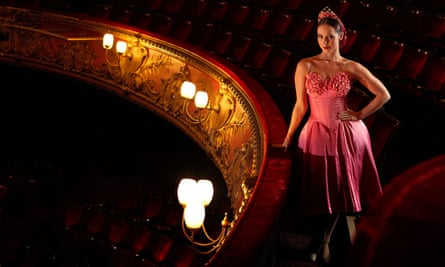
“We always wish we had longer off over Christmas,” says dancer Ashley Shaw. “Be careful what you wish for!” In a normal year, Shaw would have a hectic festive season, performing on Christmas Eve and Boxing Day. “We have Christmas Day off, but you have to be fairly sensible when you’ve got shows the next day.” So she can have an un-sensible Christmas for once? “Completely – I’m going to live it up!” But Shaw would instantly trade a day’s frivolity for being back on stage. She was due to be dancing the role of Princess Sugar in Matthew Bourne’s Nutcracker! at Sadler’s Wells theatre in London, until the show was pushed back to next year.
“It’s such a fun role,” she says. “I often play the sweet heroine, and Sugar’s a bit sassier, a bit of a baddie.” The Nutcracker is a staple of Christmas dance schedules but Bourne’s version is far from traditional. “It’s set in an orphanage and one of the girls, Clara, escapes to a fantasy place called Sweetieland where everything is made out of candy. We have a knickerbocker glory dancing around and marshmallow girls and liquorice men, so it’s very bright and colourful and fun.”
Shaw was dancing in another Bourne show, The Red Shoes, when the first lockdown hit in March, and used it as an opportunity to deal with the bone spurs on her ankle that had caused grief for years. “I thought I’d jump in and do it, because at least I might not miss anything – so that’s my silver lining.” She had the operation and went home to Australia for three months to recuperate. “I’m from a small town north of Sydney, where we had next to no cases and things were relatively normal.”
It was still a nerve-racking time, though. The dancers are all freelancers and their contracts ended, leaving them without income. “I’ve had good days and bad days. For me and every other dancer, we just miss being on stage so much. I imagine when it comes back, it’s going to be the most energised show you’ve ever seen. We used to complain about having nine shows a week. Now we would happily do it. Everyone will be mad for it!” LW
‘It’ll be like the birth of punk; theatre will find a way’
Mark Gatiss, 54, A Christmas Carol, Nottingham Playhouse and Alexandra Palace, London; postponed until October 2021
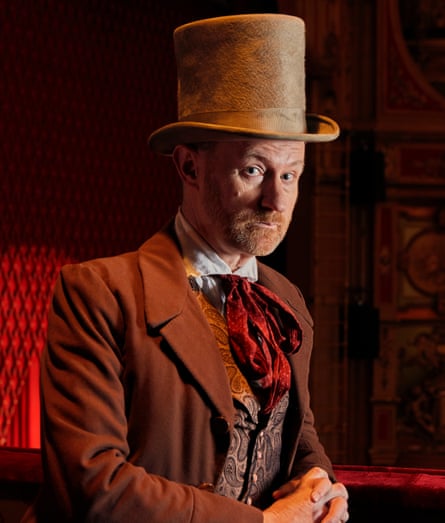
Padding around the attic of his north London home, Mark Gatiss could be forgiven for feeling glum. He should have been warming up to star in his long-planned version of A Christmas Carol, due to open in Nottingham before transferring to London. But instead the Playhouse is livestreaming its Cinderella, and the Dickens has been pushed back. Gattis grimaces. “Events, dear boy, events.”
As someone accustomed to balancing screen, radio and stage projects, Gatiss admits he rather enjoyed the first phase of lockdown: “I’ve never slept so well.” But while other creative sectors have begun to stir into life – he’s recently back from shooting a film in the Hebrides – theatre is stuck in the deep freeze, and Gatiss is withering about the government’s response. “More people go to the theatre every year than go to Premier League matches,” he argues. “And this talk of retraining, it’s pie in the sky, isn’t it?”
He’s trying not to be too gloomy. “Maybe it’ll be like the birth of punk; a lot of people desperate to make something happen will find a way.” But he worries that many theatres, already cash-strapped, will avoid risks, and he is missing the gaudiness and glitter that festive theatre brings. Last year, he went to the famously lavish panto at the London Palladium – which, unlike so many, will go ahead this year – and emerged reinvigorated.
“I don’t think I’ve ever seen so much wattage on a stage,” he says. “It just physically made us feel better – there was so much light and colour. We crave these things, don’t we? It’s like seeing the Christmas lights. It just makes you feel happy.” AD
‘If you see kids grinning, it’s worth it – you’ve done your job’
Kat B, 47, Jack And The Beanstalk, Hackney Empire, London; postponed until November 2021
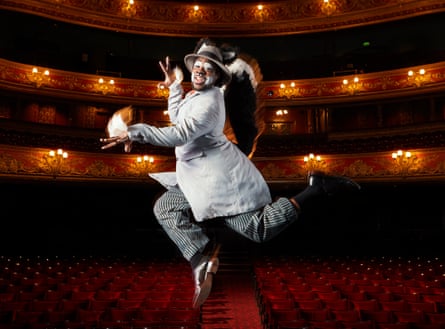
In front of me is a grown man wearing cat makeup and a trilby, delicately licking his paws. As the Zoom connection stabilises, Kat B grins, as if nothing could be more normal. The Hackney Empire panto might be on ice this year, but you suspect that one of its biggest stars is always putting on some kind of show.
This would have been Kat’s 18th year in the saddle at Hackney Empire; as it is, the closest he will get to 2020’s planned Jack And The Beanstalk is a Guardian photoshoot featuring him in costume from their 2019 version of Dick Whittington (Windrush-themed, even louder and more eye-popping than usual).
The Empire’s creative team had been hopeful that they could plough ahead – the show brings in around a fifth of their annual income – but, despite receiving emergency assistance from the government’s culture recovery fund, they decided they couldn’t take the risk. This December, the former music hall will have one of its few dark Christmases since it opened in 1901.
Kat claims to be making the most of his enforced rest. “People don’t realise how hard doing a show like this is,” he says. “You’ve got a few weeks of rehearsal, then you’re straight into it – nearly three months, from November through to January. Christmas Day, you can’t even relax: it’s like doing a marathon.”
One thing he will miss is stepping out into the roar of the crowd during a matinee, when the theatre is filled to the rafters. Around 50,000 people book for the Hackney panto each year, including nearly 10,000 children from local schools, plus many on free tickets given out to housing associations and community groups.
“The sound is immense,” Kat says, smiling. “You always forget it, and then it comes straight back. Kids are the most honest audience you’ll ever get. If you see them grinning, it’s worth it – you’ve done your job.”
Though he fears for the effect of the pandemic on British theatreland, he says places such as the Empire are determined to come back fighting. “We’re like Tyson,” he says. “When we emerge from retirement, we’ll knock heads off.” AD
Hair and makeup: Alice Theobald at Terri Manduca using Chanel Les Chaînes D’Or and Sublimage L’Extrait De Nuit, and L’Anza
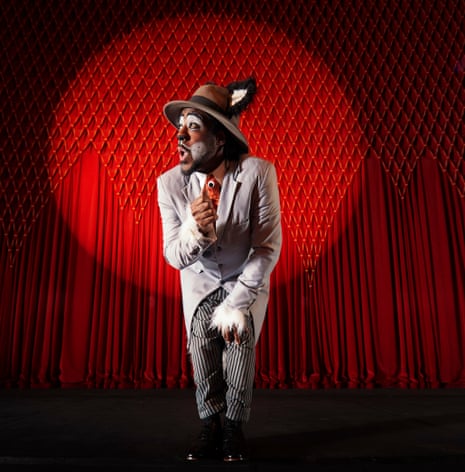
Comments (…)
Sign in or create your Guardian account to join the discussion